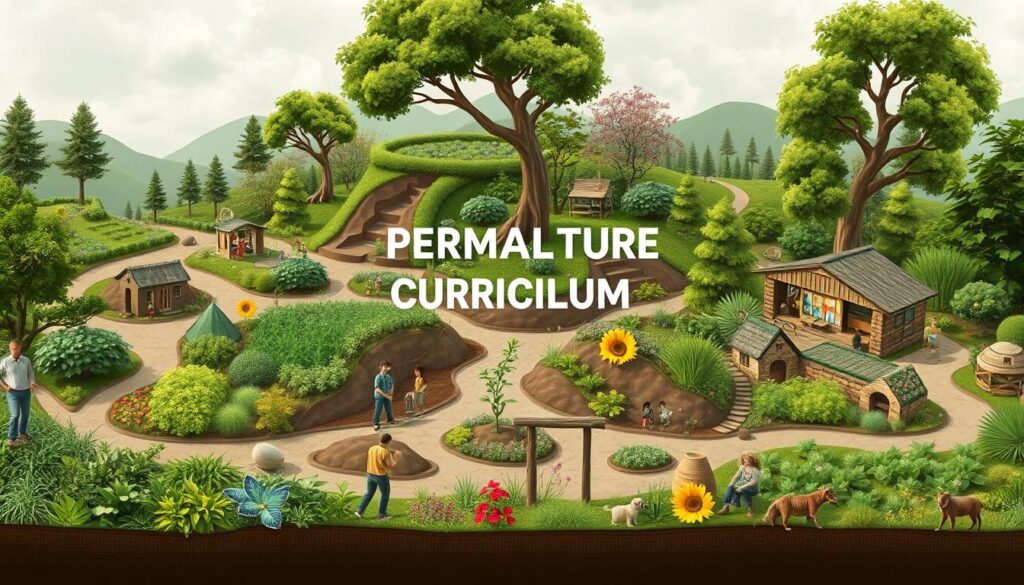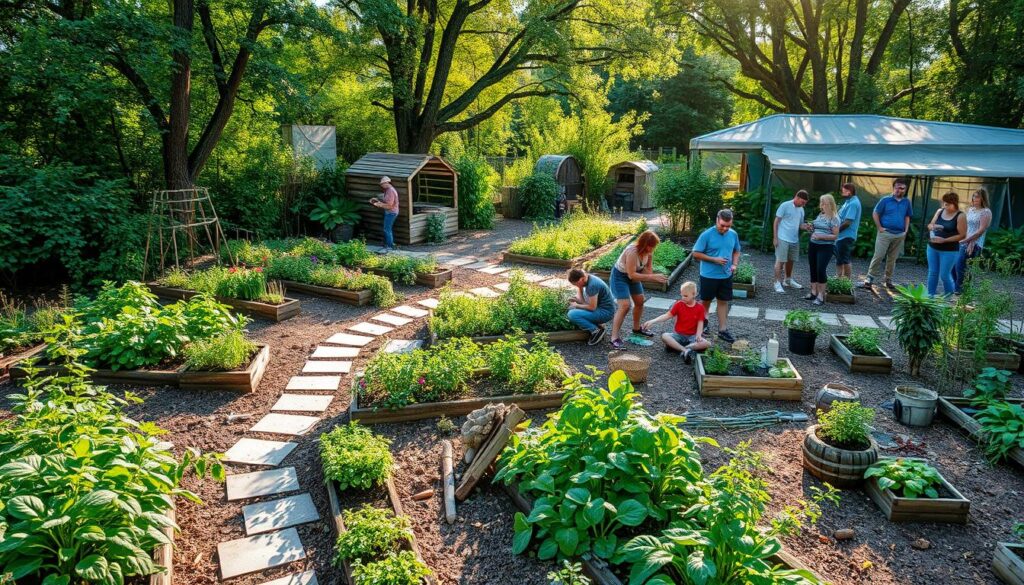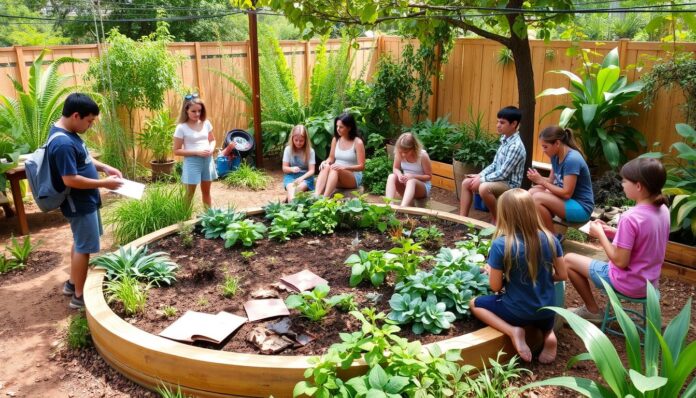What makes permaculture education effective? It’s the teaching techniques and strategies that empower people to live sustainably. Organizations like Cascadia Permaculture and Permaculture Institute USA help educators develop these methods.
Permaculture education works in many places, like Cambodia, Bangladesh, and Uganda. The Permaculture Educators Program spans 6 continents. It offers a detailed online course for both Permaculture Design and Teacher Certificates. This way, educators can make learning fun and interactive, teaching about sustainability and the environment.
Key Takeaways
- Permaculture teaching techniques and education strategies are key for sustainability and awareness.
- Groups like Cascadia Permaculture and Permaculture Institute USA provide advanced training.
- Permaculture education succeeds in places like Cambodia, Bangladesh, and Uganda.
- The Permaculture Educators Program offers a full online course with two certificates.
- Teaching permaculture focuses on sustainable methods and engaging learning spaces.
- Good permaculture education uses a pattern-to-detail approach, with breaks and meals to keep students focused.
Understanding Permaculture Principles
Permaculture is a way to design sustainable living systems. It focuses on three main ethics: caring for the Earth, people, and sharing resources. These ethics help guide the design and use of permaculture systems.
The Ethics of Permaculture
The ethics of permaculture are simple yet powerful. They remind us that our actions affect the environment and others. By living by these ethics, we can make the world more sustainable and fair. Organic gardening instruction and eco-friendly curriculum design are key in permaculture education. They teach people how to live sustainably.
The Twelve Design Principles
The twelve design principles of permaculture were created by David Holmgren. They offer a framework for sustainable systems. These principles include observing nature, catching energy, and using renewable resources. They help create regenerative agriculture education systems that are productive and diverse.
- Observe and interact with nature
- Catch and store energy
- Obtain a yield
Understanding and using permaculture principles can lead to sustainable living. This is true for organic gardening instruction, eco-friendly curriculum design, or regenerative agriculture education. Permaculture is a powerful tool for creating a better world.
Importance of Teaching Permaculture
Teaching permaculture is key for holistic learning approaches. It helps us understand how everything in our ecosystem is connected. By using green living pedagogy in schools, we teach people how to make systems that are sustainable and can grow back.
Learning about permaculture does more than just help individuals. It also helps in teaching environmental conservation tactics. This leads to more biodiversity and helps fight climate change. Some main benefits of learning about permaculture are:
- Improved ecosystem health and biodiversity
- Increased food security and self-sufficiency
- Enhanced community engagement and social bonds
- Reduced pollution and waste
By learning permaculture, we can build a better future for all. Experts from Cascadia Permaculture and Permaculture Institute USA say it changes how we see our environment. It teaches us a holistic learning approach to living sustainably.
| Benefits of Permaculture Education | Description |
|---|---|
| Improved ecosystem health | Permaculture education promotes biodiversity and ecosystem services |
| Increased food security | Permaculture practices enhance food production and self-sufficiency |
| Enhanced community engagement | Permaculture education fosters social bonds and community involvement |
Types of Permaculture Teaching Materials
Permaculture teaching techniques and education strategies are key to sustainable learning. They combine visual aids, digital resources, and hands-on activities. The Permaculture Institute USA and Cascadia Permaculture offer courses and workshops that use these methods.
Visual aids like diagrams, videos, and photos help explain important concepts. Digital resources, such as online courses and podcasts, make learning flexible. These tools support permaculture education and promote sustainable teaching.
Learning in permaculture often mixes theory and practice. Students might work on garden projects, join community workshops, or share skills. These activities make learning hands-on and support sustainable teaching methods.
| Permaculture Teaching Materials | Description |
|---|---|
| Visual Aids | Diagrams, videos, photographs |
| Digital Resources | Online courses, webinars, podcasts |
| Hands-on Activities | Garden design projects, community workshops, skill-sharing exchanges |
Curriculum Development for Permaculture
Creating a permaculture curriculum needs a holistic view. It should blend eco-friendly design and teach about regenerative agriculture. This way, students get a full and fun learning experience.
The Permaculture Institute USA says a good curriculum covers many topics. These include soil care, saving water, and using renewable energy. By adding permaculture to current courses, teachers can give students a broad view of sustainability.
Integrating Permaculture into Existing Courses
There are many ways to mix permaculture into current classes. Here are a few:
- Adding permaculture modules to existing environmental science or agriculture courses
- Creating interdisciplinary courses that combine permaculture with other subjects, such as ecology or economics
- Developing project-based learning activities that incorporate permaculture principles

Step-by-Step Curriculum Design
Designing a curriculum step by step ensures it’s thorough and works well. This process includes:
- Defining learning objectives and outcomes
- Developing a detailed course outline and syllabus
- Creating engaging and interactive learning activities
By using a step-by-step method and focusing on eco-friendly and holistic learning, educators can make a top-notch permaculture curriculum. This curriculum will ready students for a green future.
Developing Engaging Lesson Plans
Creating engaging lesson plans is key in permaculture education. Hands-on activities and interactive discussions help students grasp complex ideas. They also remember what they learn better. Project-based learning and community involvement are great strategies to teach sustainability and care for the environment.
Good lesson plans align with what students need to learn. They include fun, interactive parts. For instance, using diagrams and videos can make permaculture principles clear. Hands-on activities, like designing gardens, give students real experience and help them connect with their community.
Teachers can make learning fun and meaningful by using permaculture strategies. This approach helps students learn and appreciate the environment more. Here are some ways to do it:
- Project-based learning: Students work on real projects that teach sustainability and community involvement.
- Community engagement: Working with local groups gives students hands-on experience and teaches sustainable practices.
- Hands-on activities: Activities like garden design and workshops provide practical learning and promote sustainability.
| Permaculture Education Strategies | Benefits |
|---|---|
| Project-based learning | Promotes sustainable practices and community engagement |
| Community engagement | Provides hands-on experience and promotes sustainable practices |
| Hands-on activities | Provides practical experience and promotes sustainable practices |
Utilizing Multimedia in Teaching Materials
Teaching permaculture can be enhanced with multimedia resources. Educators can make learning more engaging by using organic gardening, eco-friendly design, and regenerative agriculture in their materials. For instance, Cascadia Permaculture and Permaculture Institute USA offer courses and workshops that use multimedia to teach permaculture.
Using multimedia in teaching has many benefits. It can make students more engaged and help them remember information better. It also makes complex ideas easier to understand through visuals. Research shows animated videos are as effective as 1.8 million words in teaching.
It also makes learning permaculture more accessible to everyone. This includes students with different learning styles and abilities.
Here are some multimedia resources for permaculture education:
- Videos and documentaries that show permaculture in action
- Podcasts and audio resources for extra information
- Interactive software tools and online platforms for hands-on learning
By adding these multimedia resources, educators can create a better permaculture education program. Whether through videos, podcasts, or interactive tools, multimedia makes learning permaculture more fun and effective.
| Resource | Description |
|---|---|
| Videos and documentaries | Showcase permaculture principles in action |
| Podcasts and audio resources | Provide additional information and insights |
| Interactive software tools | Allow students to engage with permaculture concepts in a more hands-on way |
Hands-On Activities for Practical Learning
Hands-on activities are key for learning by doing. They let students use what they’ve learned in real life. This way, they get a better grasp of the subject and feel connected to the environment. Using green living pedagogy in class helps students feel responsible and care for the planet.
One great way to learn by doing is through garden design projects. These projects help students work together, solve problems, and think critically. They also get to meet local experts in community workshops, learning from their experiences.
Garden Design Projects
Garden design projects are a special chance for students to use what they’ve learned. They help students see how everything in nature is connected. They also learn why environmental conservation is so important.
Community Workshops
Community workshops let students meet local experts and learn from them. By joining these workshops, students understand how green living pedagogy works in real life. They also improve their communication, teamwork, and problem-solving skills.
Creating Permaculture Case Studies
Permaculture case studies are key for teaching permaculture. They use permaculture teaching techniques and permaculture education strategies. For instance, the tropical permaculture homestead in Costa Rica is a prime example.
Choosing the right case studies is crucial. They should match the students’ needs and interests. Consider these factors:
- Location and climate
- Project size and scope
- Types of plants and animals used
- Water management and conservation strategies
- Waste reduction and recycling practices
Selecting Relevant Case Studies
Teachers should pick projects that show a variety of permaculture principles. Look for examples of sustainable teaching methods like rainwater harvesting and composting.

Analysis and Discussion Strategies
After picking case studies, teachers can use different strategies to help students learn. This includes:
- Group discussions and debates
- Written reflections and assignments
- Presentations and role-playing activities
- Field trips and site visits
| Case Study | Location | Project Size |
|---|---|---|
| Tropical Permaculture Homestead | Costa Rica | 10 acres |
| Urban Permaculture Project | United States | 1 acre |
Assessing Learning Outcomes in Permaculture
Checking how well students learn is key in permaculture education. It shows if eco-friendly curriculum design and regenerative agriculture education work well. Teachers use holistic learning approaches to see how students are doing and help them get better.
The Permaculture Institute USA and Cascadia Permaculture teach how to check learning. They give educators tools to see if students are learning. They stress the need for eco-friendly curriculum design and regenerative agriculture education for good learning.
Evaluation Methods and Tools
There are many ways to check if students are learning in permaculture. Teachers might use quizzes, exams, projects, or class talks. Using different methods helps teachers see how students are doing and give them feedback to get better.
Feedback as a Teaching Strategy
Feedback is very important in teaching permaculture. It helps students know their strong points and where they need to work harder. This way, students learn more about permaculture and how to apply it.
Facilitating Group Discussions and Activities
Effective group discussions and activities are key in permaculture education. They help students work together, think creatively, and understand permaculture better. Educators use special teaching methods to make learning fun and inclusive. For example, Cascadia Permaculture and Permaculture Institute USA teach group facilitation skills.
To lead good group discussions, educators should encourage everyone to listen and speak respectfully. They use different teaching methods to reach all students. This way, students feel supported and can share their thoughts freely. It makes learning better and helps build strong communities.
Permaculture education has a 72-hour curriculum to guide learning. It covers all important permaculture topics. Using various teaching methods, like lectures and hands-on projects, keeps students engaged. This approach helps students understand permaculture deeply and supports sustainable teaching.
| Permaculture Education Strategies | Description |
|---|---|
| 72-hour curriculum framework | Structures the learning process and provides a comprehensive overview of permaculture principles |
| Thoughtful and Protracted Observation (TAPO) | Cultivates a deeper understanding and perspective regarding natural systems |
| Earth Care, People Care, Fair Share | Guides class discussions and activities, emphasizing the importance of ethics in permaculture |
Resources for Teacher Training
Teachers looking to teach permaculture have many resources to help them. Organizations like the Permaculture Institute USA and Cascadia Permaculture offer workshops and certification programs. These focus on organic gardening instruction and eco-friendly curriculum design.
These programs give teachers the knowledge and skills to create engaging lesson plans. They teach regenerative agriculture education in a fun and effective way.
The Permaculture Design Course (PDC) is a 72-hour+ program. The Permaculture Education Institute’s online program lets students earn a Permaculture Design Certificate and a Permaculture Teacher Certificate at the same time. There are also online courses and webinars for teachers who need flexible learning options.
These resources help teachers keep their curriculum up-to-date. They provide high-quality education to students. By using these resources, teachers can make learning more sustainable and environmentally conscious. This helps create a better future for everyone.
Accessibility in Permaculture Education
Permaculture education focuses on holistic learning, green living, and teaching about the environment. But, making sure everyone can learn is key. Cascadia Permaculture and Permaculture Institute USA say it’s important to adapt materials and use inclusive teaching methods.
Some important things to think about for accessible permaculture education are:
- Physical accessibility: making sure spaces are easy for people with mobility issues to get to
- Financial accessibility: offering affordable ways for those with less money to learn
- Emotional and social accessibility: creating a welcoming and inclusive place to learn
Adapting Materials for Diverse Learners
It’s vital to adapt materials for different learners in permaculture education. Using various learning styles and abilities is key. Visual aids, hands-on activities, and interactive elements can help.
Also, teaching about environmental conservation can deepen learners’ understanding of permaculture.

Inclusive Teaching Strategies
Inclusive teaching is crucial for accessible permaculture education. Using green living pedagogy that emphasizes social and environmental responsibility is important. Group work, discussions, and reflections can help learners develop skills and knowledge.
Using technology, like online platforms and multimedia, can also make learning more accessible. It allows learners to study from anywhere, making education more flexible and accessible.
| Accessibility Considerations | Strategies |
|---|---|
| Physical Accessibility | Ensure accessible learning spaces, provide accommodations for learners with mobility issues |
| Financial Accessibility | Offer affordable options, provide scholarships or financial aid |
| Emotional and Social Accessibility | Create a supportive learning environment, promote inclusivity and diversity |
Engaging the Community with Permaculture
Permaculture education goes beyond the classroom. It can reach the community through sustainable teaching methods. This way, people can learn about caring for the environment and feel responsible for it. Workshops, community events, and partnerships with local groups are great ways to do this.
For example, hosting workshops, starting community gardens, and planning environmental events are good ideas. These actions help spread the word about permaculture’s value. Together, we can make our community greener and more aware of sustainability.
Also, permaculture education strategies can be used in schools and community centers. This teaches both kids and adults about permaculture’s benefits. Hands-on activities like gardening and composting, along with lessons on permaculture, are effective. This approach helps build a culture of sustainability and care for the environment.
To effectively engage the community with permaculture, we need a variety of methods. Using sustainable teaching methods, permaculture education strategies, and permaculture teaching techniques is key. By working together and teaching about permaculture, we can make our community more sustainable and environmentally conscious.
Leveraging Technology in Permaculture Education
Technology is key in making permaculture education better. It helps create learning experiences that are both immersive and interactive. This way, educators can make online courses that teach about regenerative agriculture in an engaging way. This not only helps students but also helps make our future more sustainable.
Places like Cascadia Permaculture and Permaculture Institute USA offer many courses and workshops. They focus on permaculture technology and online learning. These resources give educators the tools and knowledge to design learning experiences that meet different needs. Some important features of these platforms include:
- Interactive software tools for designing and managing permaculture projects
- Virtual tours and 3D models of permaculture sites
- Access to a community of educators and practitioners for collaboration and knowledge sharing
By using technology in permaculture education, educators can make learning more engaging and effective. This promotes learning about regenerative agriculture and holistic approaches. It not only improves student outcomes but also helps create a more sustainable future.

| Organization | Course Offerings | Features |
|---|---|---|
| Cascadia Permaculture | Permaculture Design Course, Advanced Permaculture Planning and Design Course | Interactive software tools, virtual tours, community access |
| Permaculture Institute USA | Permaculture Design Certification, Online Workshops | Eco-friendly curriculum design, regenerative agriculture education, holistic learning approaches |
Updating Teaching Materials Regularly
Keeping teaching materials fresh and relevant is key in permaculture education. Educators must update their materials often. This ensures they reflect the newest research and best practices in sustainable teaching.
The Permaculture Institute USA and Cascadia Permaculture suggest using permaculture strategies in lesson plans. This makes learning fun and interactive. Hands-on activities and real-world examples boost student interest and effort.
Here are some tips for updating teaching materials:
- Integrate new research and technologies into your curriculum.
- Use sustainable teaching methods to teach about the environment.
- Ask for feedback from students and peers to make your materials better.
By updating materials and using permaculture strategies, educators can make learning more engaging. This approach helps students learn about sustainability. It also prepares them for a greener future.
| Permaculture Education Strategies | Benefits |
|---|---|
| Hands-on activities | Increase student engagement and motivation |
| Real-world examples | Promote environmental awareness and stewardship |
| Sustainable teaching methods | Reduce environmental impact and promote sustainability |
Case Studies in Successful Permaculture Education
Permaculture education has been a hit worldwide. It shows how organic gardening instruction and eco-friendly curriculum design work. The Cascadia Permaculture program is a great example. It offers courses and workshops on permaculture.
The Permaculture Institute USA also helps out. They provide resources and training for both educators and students.
These programs have made a big difference. They teach regenerative agriculture education that helps the environment and local communities. Schools and organizations use permaculture to teach sustainable practices.
Some successful projects include:
- Community gardens and urban agriculture initiatives
- Sustainable farming and ranching practices
- Environmental conservation and restoration projects
These examples show how permaculture education can lead to positive change. By using organic gardening instruction, eco-friendly curriculum design, and regenerative agriculture education, educators can inspire a new generation. They can become environmental leaders and stewards.
| Program | Location | Impact |
|---|---|---|
| Cascadia Permaculture | USA | Trained over 1,000 students in permaculture principles |
| Permaculture Institute USA | USA | Developed curriculum and training programs for educators |
Future Trends in Permaculture Education
The need for sustainable living is growing fast. This means big changes for permaculture education. New holistic learning approaches will mix green living pedagogy and environmental conservation teaching tactics. This will make learning more real and effective.
Schools in the U.S. and Canada are adding permaculture to their courses. They see its value in teaching about community-based sustainability. More Permaculture Design Courses (PDCs) are being offered, giving students a chance to learn this important skill. Programs like the community-based sustainability major at Colby-Sawyer College show how permaculture is being taught in schools.
Teachers will keep improving their methods, using technology and hands-on learning. They will focus on making things work, getting involved in the community, and finding solutions. This will help students make a difference in their own areas. As permaculture grows, so will the talk about its place in schools, keeping education fresh and changing.

